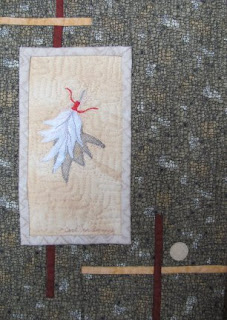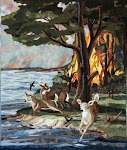The procedures I follow when assembling my designs have me behaving
like a construction site supervisor. It amuses me to imagine wearing a hard hat
while working on my pictorials. There is an informal organization plan I rely
upon to oversee the building of a wall hanging, large or small. I rarely
diverge from this scheme and offer a view in this posting and the next ones.
Planning Phase. Long ago I established a routine when
dealing with creative musings, which may have been sparked by reading, by something
seen on a walk, or by brainstorming a flash of an idea popping into mind. I
spend a lot of time stewing, planning, wrestling and turning
ideas around, examining them from all angles. My reality is if I do not “see” a
fairly clear picture in my mind for a design, it will be a struggle to capture
it on paper, and eventually be discarded.
A sketchbook tends to be my starting point and I spend time
making many small rudimentary sketches trying to anchor a spark before it is
lost. For Watchful, this began with
seeing a dog sitting on top of a pick-up truck in a parking lot. I did not have my
camera, but I whipped out my sketchbook I carry with me everywhere.
 |
| A rough drawing to capture the essence of concern |
Master Pattern: The advantage of doing sketches followed by refined drawings is, I become more familiar with the design concept, am able to start planning the compositional layout and begin resolving potential problems I may confront long before I commit fabric and time. Paper is cheap. Textiles are not. The next step will be drawing a refined, full-size master pattern that becomes the road map (site plan), which is never cut up during construction. Again, I am becoming more intimate with the design and its challenges. A critical review of the master plan will take place before picking up the scissors to begin the work. Of course, adjustments and changes do occur during the process of stitching and completing the work.
.jpg) |
| A full size master drawing is created. |
Work Routine. I use to stitch everything by hand, but
concluded I will not live long enough to finish all my ideas. Consequently, my preference
is machine appliqué with turned under edges, machine embroidery and quilting. After
selecting fabric, I cut out swatches to make a “swatch board” with notes to
remind me of decisions made, thus, reducing the need to revisit decisions each
time I return to my studio. Next, I will begin by tracing, marking and cutting freezer
paper templates starting with the main character and begin stitching together
the body parts. In this example, it is a wolf.
Contrary to traditional appliqué, the backgrounds and support
layers are the last choices I make. I work my designs from the top down to the
backdrop layers to avoid being doomed by poor choices that may not work well in
the long run. I do not want to rip out and redo. As a result, I will have body
parts, or other segments, strewn about my studio awaiting further development. When enough segments have been assembled and are ready
to be pulled together, I am able to fit the units with its adjacent details like
putting a picture puzzle together.
Another example to show how body parts and other elements are constructed separately from the eventual full design is in this photo:
Another example to show how body parts and other elements are constructed separately from the eventual full design is in this photo:

.JPG)
.jpg)
.jpg)







 The question may be what kinds of items go into each envelope?
The question may be what kinds of items go into each envelope?




.jpg)


